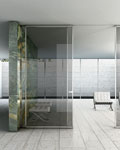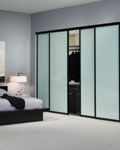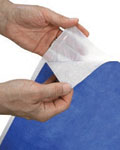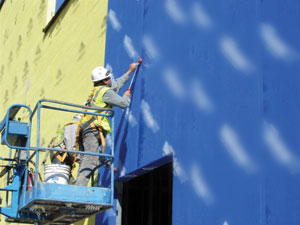Room for Luxury and Energy Efficiency: Hospitality Goes Green
Cool roofs can reduce building maintenance expenses and lower HVAC energy consumption. Cool roof applications can also qualify for rebates from utility companies or government sponsored energy programs. DSIRE9 is a Database of State Incentives for Renewables & Efficiency and is a resource that can be consulted for additional savings for renovations and new construction. Sponsored by North Carolina State University, this database provides lists of incentives by state of available grants and tax rebates. The Cool Roof Ratings Council provides data on products with qualifying solar reflectivity and thermal emittance of cool roof surfaces.
Hurst Conference Center: |
When builders were ready to install the air barrier membrane on the Hurst Conference Center in early 2010, they encountered uncharacteristically cold, 40-degree weather that broke a 32-year record for snowfall in the city. "In Texas, the weather in January and February is unpredictable," said Brett Kilgore, Texas field sales representative for Henry Company, "One day it could be 70 degrees, the next it could be snowing to 12 inches." The extremes of weather in the Dallas/Fort Worth metropolitan area, where Hurst is located and where the temperature exceeds 100 degrees Fahrenheit 20 to 30 days of the year, made wrapping the new convention center in a vapor-permeable air barrier membrane necessary to ensure that the building's heating, ventilation and air conditioning (HVAC) system operates at peak efficiency. A vapor-permeable air barrier membrane keeps conditioned air in and unconditioned air out, while allowing moisture to evaporate out of the building. Its vapor permeability also allows evaporated moisture to pass through the building, which enables the substrates to dry. The project required approximately 36,000 square feet of the air barrier membrane, amounting to 76 rolls. The building had few windows, but large expanses of walls. The installation was completed mid-February 2010. In addition to making installation more efficient, the air barrier membrane's self-adhesive backing also creates a complete, positive seal of the entire building by following all of the contours of the substrate. This membrane will self-seal when penetrated with self-tapping screws. It adheres to prepared substrates of concrete, concrete block, primed steel, aluminum milled finish, anodized aluminum, galvanized metal, gypsum board and plywood. This tight building seal creates no air locks, which helps to prevent any loss of pressure and causing air leaks. Additionally, the air barrier also resists high winds and negative pressure, making it compliant with ASTM 2357.
In comparison to mechanically fastened building wraps that are more commonplace, self-adhered air barrier membranes require fewer steps to install, as their self-adhesive backings eliminate the need to use stainless steel fasteners to affix the product to the substrate (the fastener heads also must be covered with tape after installation in order to maintain the building's seal). The air barrier membrane was installed without the use of power tools; only rollers were required to secure the product to the substrate. |
The air barrier membrane was installed without the use of power tools at the Hurst Conference Center in Texas. Only rollers were required to secure the product to the substrate. Photo courtesy of Henry Company |
Â
Conclusion: Guidelines for Going Green
The American Hotel and Lodging Association (AH&LA) published a list of minimum actions that properties of any size should take to be able to claim themselves as an eco-friendly or green hotel. The list includes links to online resources to educate their member hotels on additional practices and principles. Some of these top practices can impact the design of a hotel property and include the development of an environmental plan for energy, water and solid waste as well as monitoring a hotel's environmental performance on both a monthly and annual basis.
Their members are encouraged to buy ENERGY STAR appliances and use highly efficient toilet fixtures, faucets and showerheads as well as materials beneficial to the environment. This association directs their members to a green guru who can answer questions about facilities and provide consulting services that include facilities evaluation, recommendations of eco-friendly products and procedures, energy audits, the review of an organization's carbon footprint as well as many other opportunities for cost savings.10
Third-party Certifications
Numerous third-party certification programs provide guidance to the designers of buildings for the travel and tourist industry. EarthCheck, Green Key, The Rainforest Alliance, The Sustainable Tourism Eco-certification Program, the Green Tourism Business Scheme, and the Certification for Sustainable Tourism are just a few that complement numerous other rating systems such as the U.S. Green Building Council.
Among these certification programs is The Global Green Hospitality Consortium (GGHC). GGHC is a non-profit organization founded to provide guidelines that will continuously improve the ability of businesses, building owners and management in the hospitality industry to increase and make positive impact on "our shared environment through the reduction of energy, water, materials and other resources while creating positive business results."11 This organization provides third-party certification to hospitality properties worldwide. Property certification includes the attainment of a bronze, gold or silver certification among other elements based on a review of energy audits, EPA benchmarks, ENERGY STAR labeling and LEED certification. This organization provides assistance in leveraging available rebates. They provide product certification, validation of return on investment, performance testing and review of technical specifications. They also provide educational programs focused on sustainability and the hospitality industry.
Notice

www.modernus.com/products/sliding

www.slidingdoorco.com

www.henry.com










